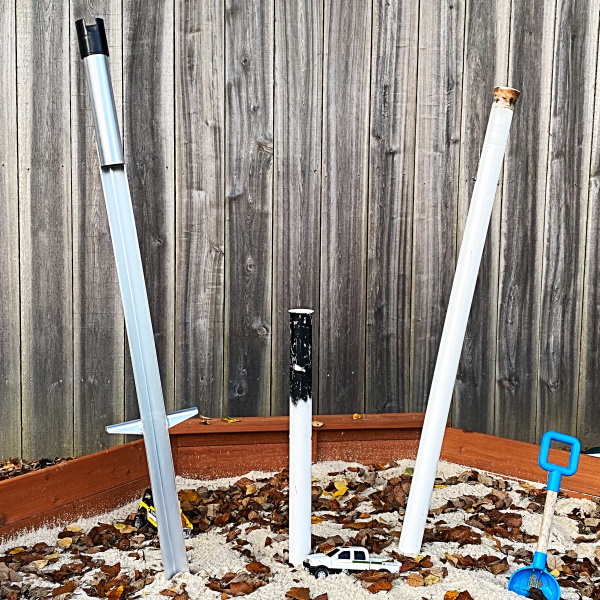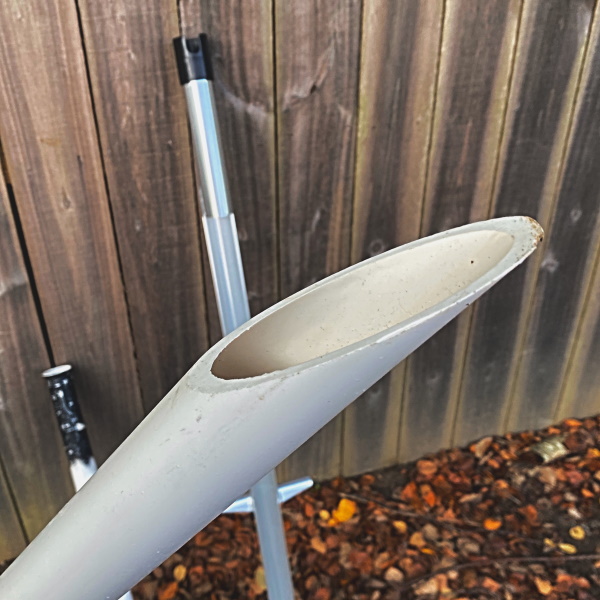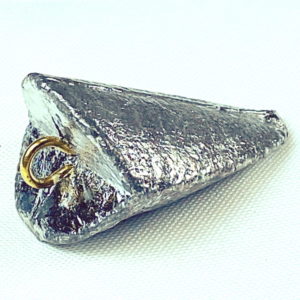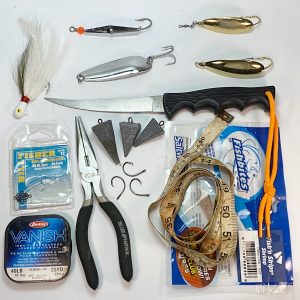*As an Amazon Associate I earn from qualifying purchases.

Besides a rod and reel, a good sand spike is one of the most important pieces of gear you’ll take to the beach. The best rod holder is your two hands, but unless your plan is walk the beach and cast all day, you’ll need somewhere to set your rod down.
Salt and sand are mortal enemies of fishing reels, so you should avoid placing your rod and reel on the ground at all cost. Below are the best sand spikes for surf fishing that I know of. Each has it’s pros and cons, but you’ll need to choose something. My personal preference is the aluminum Fish-N-Mate 266 Sand Spike, but let’s take a look at what all your options are. Then, you can decide for yourself.
5 Best Types Of Sand Spikes
- Homemade PVC
- Homemade Aluminum+PVC
- Store Bought PVC
- Ground Spike Rod Holders
- Solid Aluminum
1. Homemade PVC Sand Spike
The cheapest option for a quality sand spike is to simply make your own. All the materials you need can be easily purchased from a local hardware store, and quickly assembled at home. Homemade rod holders are generally made from thicker PVC tubing than similar items purchased in a store, so they are actually stronger and more durable.
The weight of my homemade surf spike, pictured at the top right, is 1.93 lbs. The weight can be adjusted by either using a lighter weight PVC (Sch. 30), or by making the spike a little shorter. Although it can save you some weight, I wouldn’t really advise going with a lighter weight PVC. Thin walled PVC results in a weaker tip that is more prone to bend and break when you drive it into the sand.
Build A PVC Rod Holder
To build your own PVC rod holders, purchase a 10 foot section of 1.5” Sch. 40 PVC and cut it in half. If you don’t want to deal with transporting a 10 foot pole, they’ll cut it in half for you at the store.
On one end of your pipe, cut a 45 degree, or sharper, angle so that you can easily push it into the sand. I find that about a 5” angled cut is just about right. This is a sharp enough angle that it inserts easily into the sand, but yet it is not so pointy that it’s weak at the tip.

Next, you’ll need to sand off any rough spots where your rod is inserted, so as to prevent any damage to your rod’s finish. At that point, you could technically call it done, and use it that way. However, I don’t like the wear and tear that this “unfinished” design puts on my rod and reel. Instead, you could take it a couple more steps to get your homemade spike more in line with what you might purchase from a store.
Homemade PVC Surf Spike Improvements
There are a couple of improvements you should make to your serviceable surf spike to make it into a really good sand spike.
The two main improvements you need are a flared end, and a stopper of some sort to keep your rod from sliding all the way into the pipe.
Flare The End Of The Pipe
The flared end will prevent damage to your rod and reel from the sharp 90 degree angle of a cut pipe. It will also take some stress off of the reel seat. Unfortunately, I didn’t do a great job with the flaring of my homemade spike shown below. So, I attached a video of a young man that seemed to get a good outcome when he flared his own rod holder.
Add A Stopper
Something has to serve as the method to prevent your rod from falling deep within the pipe. Having the reel serve as that stopper is not ideal. The first year I used homemade sand spikes, I neglected to add a bolt or pin to keep the rod butt at a certain height. As a result, I still have reels with worn off paint on the reel foot from that first year.
There are many different ways you could stop the rod butt from falling into the pipe. The most common of which is either a bolt or a pin of some sort inserted straight through the pipe. The stopper will keep the reel foot from sitting on the mouth of the pipe.

As far as how far down you place your stopper, that’s personal preference really. I sort of like how the guy in the video above made his adjustable. If you don’t want to do that, here are the 2 lengths from my PVC spikes. My homemade version has a bolt 8″ from the top, my purchased PVC holder has a riveted pin 11″ down, and my aluminum holder actually does not have a stopper. Instead, it relies on a soft plastic end cap to buffer the reel seat from the metal edge. I might try to add a stopper to it at some point.
2. Homemade Aluminum + PVC Sand Spike
An improvement over a solid PVC sand spike is one constructed using a combination of aluminum and PVC. The aluminum stake provides several advantages over PVC. Firstly, it gives you a more secure anchor into the sand. It also allows you to insert the spike into the sand with less effort, and without the use of a rubber mallet. Thirdly, the pointy end of an aluminum stake will not bend and break like PVC is prone to do.
Build A Sand Spike With Aluminum And PVC
Combining two materials does complicate assembly a bit over just using PVC. It also increases the cost, as aluminum angle is certainly more expensive than PVC tubing. However, it does make for a more durable rod holder.
Basically, what you want to do is attach a short section of PVC to an aluminum angle stake. You’ll need a section of (1/8″x1.5″x50″) aluminum angle, and a 12″ section of 1.5″ Sch. 40 PVC. There are several ways to attach the 2 pieces. Use stainless steel bolts, hose clamps, or a combination of the 2, to marry the 2 pieces together. Finally, as with any homemade sand spike, you’ll want to make sure you flare the mouth.
3. Store Bought PVC Sand Spike
Although store bought PVC sand spikes get a bad rap, I think they are a fine for a beginner or a tourist. When I first started surf fishing, I used them a lot, and I never had a large fish pull my rod into the water. With that said, I NEVER forgot to loosen my drag when my rod was in the spike. That is a critical thing to remember, especially with cheaper rod holders.
The reason these are so cheap is because they’re usually made with a lightweight PVC (not Sch. 40), and they’re often very short. The lightweight PVC doesn’t make for a very strong pointy end. Therefore, they are much more prone to bend and break when inserting them into the ground. These would not be ideal if you fish on beaches with rocks or very hard packed sand. I was using them along the Gulf Coast, where the beaches consist of very soft sand and no rocks. So, I was able to make due with them for a while.
A couple nice benefits you get with this style of spike are that they are very cheap, and they are very lightweight. Carrying 3 of these across the sand is no problem at all. Don’t expect them to last long with heavy use, but for an individual visiting the beach on vacation, they are just fine.
4. Ground Spike Rod Holders

* Click image above to view prices on Amazon
Ground spike rod holders are the same concept as a homemade PVC+Aluminum sand spike. They have a plastic section to hold the rod attached to an aluminum stake that goes into the ground. I don’t have any personal experience with this style, but supposedly they are a bit wobbly. These are a lightweight and affordable option if you don’t feel up to building your own.
5. Solid Aluminum Surf Spike

The best surf spike options are those constructed of solid aluminum. Aluminum spikes are very durable, long lasting, and lightweight, but these features do come at a cost. Aluminum spikes are definitely going to be the most expensive option. I personally think they are worth the price, but you’ll have to make your own decision as to whether they fit into your budget.
The most widely available and reputable aluminum surf spike is the Fish-N-Mate Surf Spike, pictured above. Unfortunately, the Fish-N-Mate seems to go in and out of stock on Amazon. I suspect that’s because they’re so popular. Nevertheless, if you aren’t able to time it right, another good option on Amazon is the Exact Design Sand Spike with Bait Box.
PVC vs Aluminum Sand Spikes
Below is a breakdown of the 3 types that I own. I measured and weighed all three styles pictured at the top. One takeaway I get from the resulting chart below, is that a solid aluminum surf spike has an outstanding length to weight ratio. When considering the longevity and strength you gain from an aluminum spike, they are well worth your consideration, if you can get past the initial cost.
| Type Of Spike | Length | Weight | Price |
|---|---|---|---|
| Homemade PVC | 46″ | 1.93 lbs. | $3-$5 |
| Purchased PVC | 27″ | .60 lbs. | $6-$10 |
| Aluminum* | 50″ | 2.08 lbs. | $30-$60 |
Conclusion
While there are a few other designs on the market, these are the most common ones you’ll encounter. Any of these 5 styles will work fine IF you remember to loosen your drag. You must always keep your drag loose when your rod is in a surf spike. Otherwise, you risk losing your rod and reel to a feisty shark or bull redfish. A sturdy aluminum rod holder provides good protection from this, but even they aren’t 100%.
Augustus Clay
If you liked this article, you might also be interested in the one I wrote here about going surf fishing on a family beach vacation.



